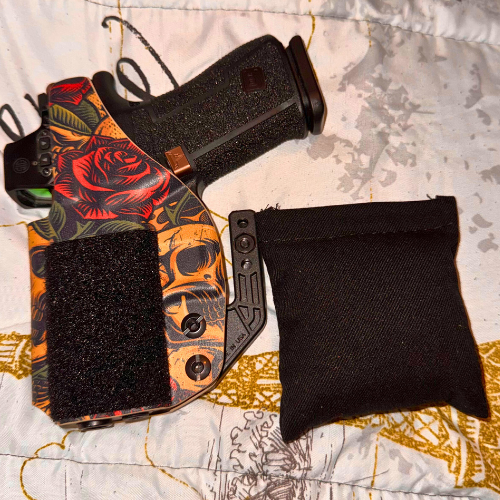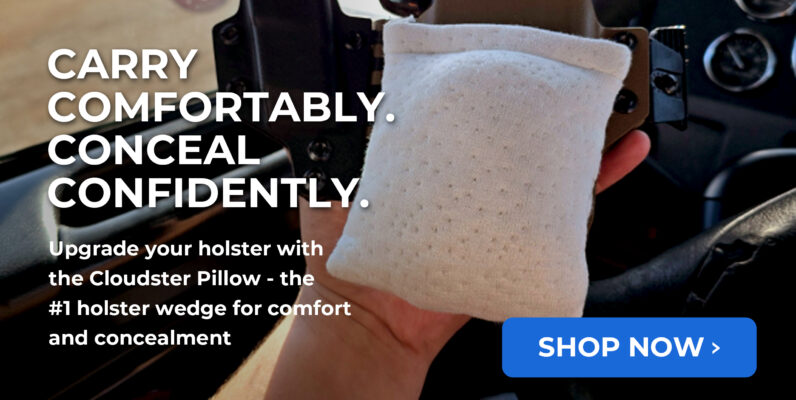AIWB
How to Install and Adjust Your AIWB Holster Wedge for Perfect Concealment Primary Keyword: AIWB holster wedge
How to Install and Adjust Your AIWB Holster Wedge for Perfect Concealment
This comprehensive guide walks you step-by-step through installation, adjustment, testing, and fine-tuning so you get the perfect setup for all-day comfort and zero printing. Whether you’re brand new to AIWB or looking to improve an existing setup, this tutorial will help you dial in the ideal fit.
Why an AIWB Holster Wedge Matters More Than Holster Design
Many concealed carriers mistakenly believe their discomfort or printing issues are because they “haven’t found the right holster.” But the truth is simpler:
The holster isn’t the problem—your anatomy is.
The angles of your pelvis, the shape of your lower abdomen, your posture, and the way your belt compresses your holster all influence pressure and concealment. A rigid Kydex holster can’t adapt to these variables. But a properly positioned wedge can.
A wedge creates leverage at the muzzle, pushing the bottom of the holster outward just enough to rotate the grip inward. This single adjustment is the key to great AIWB performance. Even top trainers and industry authorities—including resources from the U.S. Concealed Carry Association and Firearm Trainers Association—outline the importance of wedges and holster geometry.
Instead of forcing your body to adapt to the holster, the wedge allows the holster to adapt to your body.
What You’ll Need Before You Begin
- Your unloaded firearm
- Your AIWB holster (Kydex, hybrid, or sidecar)
- Your holster wedge — foam, hybrid, or a plush adjustable wedge like the Cloudster Pillow
- Hook-and-loop fasteners (included with Cloudster Pillow)
- Alcohol wipes
- A sturdy gun belt
- A mirror and good lighting
Safety Reminder: Always clear your firearm completely before doing any fitting or adjustments.
Step 1: Prep Your Holster for Installation
Before attaching your wedge, you need a clean surface for the adhesive to bond properly. Rushed prep is one of the top reasons wedge adhesives fail.
- Verify your firearm is unloaded.
Remove all ammo from the area and double-check the chamber. - Identify the correct mounting location.
The wedge mounts on the body-facing side of the holster at the muzzle end. - Clean the surface with alcohol.
Sweat, lint, and oils weaken adhesive. Clean thoroughly and allow to dry. - Apply the loop-side Velcro.
Press firmly for 30 seconds and allow 2–6 hours of cure time.
This alone solves most “my wedge keeps falling off” complaints.
Step 2: Attach the Wedge (Initial Placement)
You’ll begin with a baseline placement, then adjust later as needed.
Vertical Placement: As low toward the muzzle as possible for maximum leverage.
Horizontal Placement: Centered left-to-right to avoid uneven pressure.
This is only your starting point—not your final setup.
Step 3: Perform the Critical “Test Fit”
Before inserting your firearm, insert only the holster.
- Put on your belt normally.
- Insert the empty holster at your appendix position.
- Evaluate comfort and concealment.
Comfort Checks
- Stand
- Sit
- Bend forward
- Bring knees up (car test)
Watch for sharp spots, poking, or pressure buildup.
Concealment Checks
- Look for grip printing
- Check for muzzle bulge
- Ensure the holster lies flush
Don’t expect perfection on the first attempt. The test phase shows what needs adjusting.
Step 4: Fine-Tuning Your AIWB Holster Wedge
Most adjustments fall into one of three categories.
Problem 1: Wedge Feels Too Thick or Aggressive
This can cause discomfort or excessive muzzle bulge.
Fixes:
- Using the Cloudster Pillow: Unzip and remove a small pinch of shredded memory foam.
- Move the wedge slightly upward on the holster.
- Try a thinner wedge if using fixed-size foam.
Problem 2: Wedge Is Too Thin (Grip Still Prints)
Fixes:
- Add more fill if using a Cloudster Pillow (extra fill bag included).
- Move wedge lower toward the muzzle for more leverage.
- Switch to a thicker wedge if using basic foam.
Problem 3: A Specific Hotspot Is Causing Pain
This usually means the wedge needs micro-positioning.
Fixes:
- Move the wedge left or right slightly.
- Rotate it 10–15 degrees.
- Redistribute memory-foam fill inside your Cloudster Pillow.
This is where adjustable pillow-style wedges shine—they adapt to your anatomy instead of forcing pressure into one point.
Step 5: Final Fitment With Your Unloaded Firearm
Once your holster feels right, insert your unloaded firearm and wear your setup for 30–60 minutes.
- Walk around
- Sit and stand repeatedly
- Drive
- Check printing again
Only when both concealment and comfort are perfect do you lock in your setup.
Why Adjustable Pillow-Style Wedges Outperform Foam Blocks
Soft, shredded memory-foam wedges like the Cloudster Pillow offer superior performance because they naturally conform to your body. Unlike dense foam blocks, they distribute pressure instead of concentrating it.
Benefits of pillow-style wedges:
- Better grip tuck
- No hotspots
- Comfort while driving
- Reduced groin and pelvic pressure
- Customizable thickness
- All-day carry comfort
It’s the reason thousands of concealed carriers upgrade to a Cloudster Pillow holster wedge after struggling with hard foam wedges.
FAQs About AIWB Holster Wedges
1. Best place to mount a wedge?
At the muzzle end on the body-facing side.
2. Can a wedge be too big?
Yes—oversized wedges cause bulging and discomfort.
3. Will a wedge help with IWB at 3–4 o’clock?
Yes, wedges help reduce printing even in hip carry.
4. Why does my wedge fall off?
Improper surface prep or not allowing adhesive to cure.
5. Soft or hard wedge?
Most carriers prefer soft adjustable wedges for comfort.
Conclusion: Your Perfect AIWB Setup Starts With the Right Wedge
A properly installed and tuned AIWB holster wedge is the foundation of superior comfort and concealment. Once the wedge sets the correct angle, the holster naturally conforms to your body, eliminating printing and pressure issues.
And while many wedges can improve your setup, adjustable pillow-style wedges deliver the highest comfort and most reliable concealment outcome—especially for long days and active movement.
For the best results, upgrade to the Cloudster Pillow, the #1 rated holster wedge trusted by concealed carriers nationwide.



